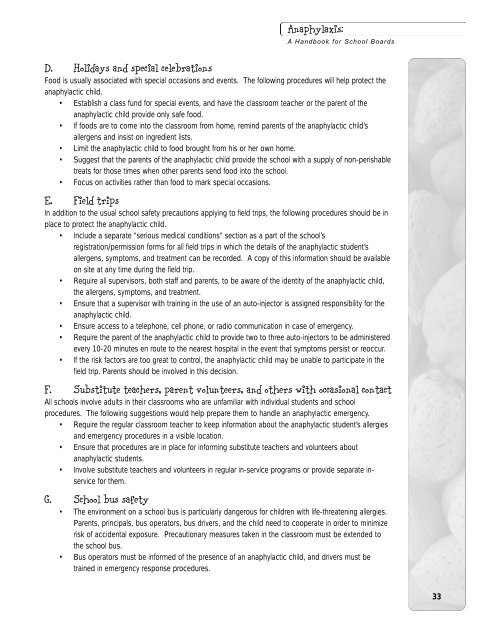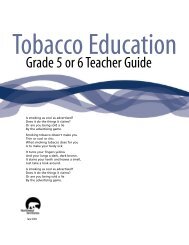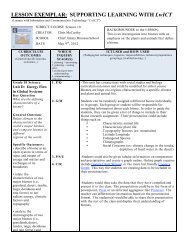Anaphylaxis: A Handbook for School Boards - Education, Culture ...
Anaphylaxis: A Handbook for School Boards - Education, Culture ...
Anaphylaxis: A Handbook for School Boards - Education, Culture ...
You also want an ePaper? Increase the reach of your titles
YUMPU automatically turns print PDFs into web optimized ePapers that Google loves.
<strong>Anaphylaxis</strong>:A <strong>Handbook</strong> <strong>for</strong> <strong>School</strong> <strong>Boards</strong>D. Holidays and special celebrationsFood is usually associated with special occasions and events. The following procedures will help protect theanaphylactic child.• Establish a class fund <strong>for</strong> special events, and have the classroom teacher or the parent of theanaphylactic child provide only safe food.• If foods are to come into the classroom from home, remind parents of the anaphylactic child’sallergens and insist on ingredient lists.• Limit the anaphylactic child to food brought from his or her own home.• Suggest that the parents of the anaphylactic child provide the school with a supply of non-perishabletreats <strong>for</strong> those times when other parents send food into the school.• Focus on activities rather than food to mark special occasions.E. Field tripsIn addition to the usual school safety precautions applying to field trips, the following procedures should be inplace to protect the anaphylactic child.• Include a separate “serious medical conditions” section as a part of the school’sregistration/permission <strong>for</strong>ms <strong>for</strong> all field trips in which the details of the anaphylactic student’sallergens, symptoms, and treatment can be recorded. A copy of this in<strong>for</strong>mation should be availableon site at any time during the field trip.• Require all supervisors, both staff and parents, to be aware of the identity of the anaphylactic child,the allergens, symptoms, and treatment.• Ensure that a supervisor with training in the use of an auto-injector is assigned responsibility <strong>for</strong> theanaphylactic child.• Ensure access to a telephone, cell phone, or radio communication in case of emergency.• Require the parent of the anaphylactic child to provide two to three auto-injectors to be administeredevery 10-20 minutes en route to the nearest hospital in the event that symptoms persist or reoccur.• If the risk factors are too great to control, the anaphylactic child may be unable to participate in thefield trip. Parents should be involved in this decision.F. Substitute teachers, parent volunteers, and others with occasional contactAll schools involve adults in their classrooms who are unfamiliar with individual students and schoolprocedures. The following suggestions would help prepare them to handle an anaphylactic emergency.• Require the regular classroom teacher to keep in<strong>for</strong>mation about the anaphylactic student’s allergiesand emergency procedures in a visible location.• Ensure that procedures are in place <strong>for</strong> in<strong>for</strong>ming substitute teachers and volunteers aboutanaphylactic students.• Involve substitute teachers and volunteers in regular in-service programs or provide separate inservice<strong>for</strong> them.G. <strong>School</strong> bus safety• The environment on a school bus is particularly dangerous <strong>for</strong> children with life-threatening allergies.Parents, principals, bus operators, bus drivers, and the child need to cooperate in order to minimizerisk of accidental exposure. Precautionary measures taken in the classroom must be extended tothe school bus.• Bus operators must be in<strong>for</strong>med of the presence of an anaphylactic child, and drivers must betrained in emergency response procedures.33
















